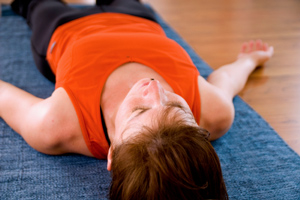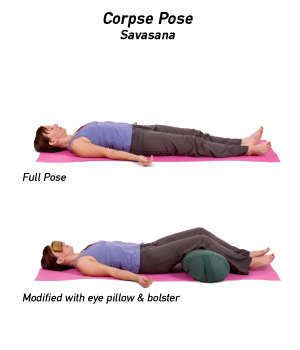How to Do Corpse Pose in Yoga

The final pose of any yoga class is one of deep restoration: Corpse Pose, also sometimes called Final Relaxation Pose. Its Sanskrit name, “Savasana” (shah-VAHS-uh-nuh), comes from two words. The first is “Sava” (meaning “corpse”), and the second is “asana” (meaning “pose”). Savasana implies a depth of release that goes beyond simple relaxation. This resting pose takes your yoga practice to a place where you can completely let go.
Though it may seem like an easy pose, Savasana can actually be very tough to learn and practice well. The great yoga masters K. Pattabhi Jois and B.K.S. Iyengar even called Savasana the most difficult of all yoga poses. For many students, the ability to lie completely still — like a corpse — while being both fully aware of and unattached from the present moment takes much practice and patience. Unlike active, moving, and physically demanding poses, Savasana requires a conscious decision to release the mental chatter and surrender fully into a state of presence.
The Most Important Pose in Yoga
Many, if not most, yoga traditions and yoga teachers regard Savasana as the single most important pose of your practice. For one thing, it allows your body time to process the information and benefits received from the poses (“asanas”) and breathing exercises (“pranayama”). But the benefits of Savasana are much more than just physical — this pose enhances and renews the body, mind, and spirit.
Savasana is not nap time — you don't actually fall asleep when practicing it. Instead, the idea is to remain present and aware for the complete duration of the pose. Doing so allows the mental chatter to settle, bringing your awareness even deeper into your innermost and highest state of consciousness. As you go deeper, you can begin to release the tangled knots of patterns (“samskaras”), emotions, and ideas that unconsciously guide your life — freeing you to become more whole and complete in your true essence.
Through the process of practicing Savasana, you can begin to view your life with more clarity and new awareness. The rejuvenating and mind-clearing aspects of Savasana provide you with the tools to deal with stress and emotions in your life off the mat.
Benefits of Savasana
Though it's sometimes used to begin practice, Savasana is most often used to end practice to allow your body, mind, and spirit to fully relax and release tension. It's a time to let lingering thoughts and worries fade away. From the depth and darkness of Savasana, you can be rejuvenated, refreshed, and reborn.
The deeply relaxing aspect of Savasana is known to be therapeutic for stress. When you're under stress, your sympathetic nervous system produces a “fight or flight” response that can over-stimulate your mind and body, causing anxiety, fatigue, depression, and disease. Conversely, practicing Savasana stimulates the parasympathetic nervous system — known as the “rest and digest” response. Relaxing the physical body in Savasana has numerous benefits, including:
- Lowered blood pressure
- A decreased heart rate
- Slowed rate of respiration
- Decreased muscle tension
- Decreased metabolic rate
The physical response can further result in:
- Reduced occurrence of headaches
- Relief from fatigue and insomnia
- Reduced nervous tension
- Relief from anxiety and panic attacks
- Increased overall energy levels
- Increased productivity
- Improved concentration and memory
- Clear-headedness and a sense of focus
- Heightened self-confidence
In addition to the mind-body benefits, Savasana is also a time during your practice when you can connect with your peaceful, innermost self. The word “yoga” is often translated as “union,” referring to the connection between your mind, body, and spirit. When you settle into Savasana and become aware of this connection, you are truly practicing yoga.
Savasana is where people are most likely to experience the meaning of yoga, which is their conscious unity with Infinity… You lie there and look dead, but as you relax and sink into the feeling of the very alive energy that is being you, it literally feels like you come to life again.
Cautions
Savasana is appropriate for all yoga students. If you are uncomfortable lying on your back, practice a supported version of the pose (see Modifications & Variations, below). Women who are pregnant should keep their head and chest raised in the pose by resting on a bolster or cushion. Always work within your own range of limits and abilities. If you have any medical concerns, talk with your doctor before practicing yoga.
Instructions

- Lie on your back with your legs straight and arms at your sides. Rest your hands about six inches away from your body with your palms up. Let your feet drop open. Close your eyes. You may want to cover your body with a blanket.
- Let your breath occur naturally.
- Allow your body to feel heavy on the ground.
- Working from the soles of your feet up to the crown of your head, consciously release every body part, organ, and cell.
- Relax your face. Let your eyes drop deep into their sockets. Invite peace and silence into your mind, body, and soul.
- Stay in Savasana for five minutes for every 30 minutes of your practice.
- To exit the pose, first begin to deepen your breath. Bringing gentle movement and awareness back to your body, wiggling your fingers and toes. Roll to your right side and rest there for a moment. With an inhalation, gently press yourself into a comfortable seated position. Let your head be the last thing to come into place. Carry the peace and stillness of Savasana with you throughout the rest of your day.
Modifications & Variations
Since Savasana is such an important pose — and is often practiced for several minutes — it's vital to feel comfortable when practicing it. Make whatever adjustments you need to feel fully supported in the pose. Here are some suggestions:
- The body often cools down significantly after practice when resting in Savasana. You may want to keep a blanket, sweater, or a pair of socks close by to cover yourself up before settling into the pose.
- If your low back is tight, it can be difficult to lie on your back comfortably. Placing a bolster underneath your knees takes weight off of your pelvis, which can allow the lumbar vertebrae and lower back to release and relax.
- Don't be afraid to use props, even if you don't need them! For instance, eye pillows work wonders to block out the light in a studio with bright windows or non-dimmable lights. If you don't have an eye pillow, place a folded towel over your eyes. You can also try a bolster under your knees; 10-pound sand bags draped across your thighs; or a folded blanket beneath your shoulder blades.
- Women who are pregnant should not lie completely flat in Savasana. Instead, rest the upper body on a bolster or stack of firm pillows and blankets, keeping the chest and head above the belly.
Tips
Whether you're brand new to yoga or have been practicing for many years, there's one tip that applies to everyone: Don't skip Savasana!
The final relaxation portion of your practice is crucial. If you must leave class early, let your teacher know in advance, and take a short Savasana before you leave. In general, however, plan never to miss out on this pose. Take your time exiting the deep relaxation — doing so will help you keep the calm presence and focus throughout the rest of your day.
If you find yourself falling asleep in Savasana, take the necessary steps to address fatigue and sleep problems outside of your yoga practice. You may want to check out the iSport guides, Yoga for Insomnia and Yoga for Stress Relief if dozing off in Savasana becomes a habit.
Relax to Renew
Practice Savasana at the end of every asana and pranayama session. You can also do Savasana on its own, in place of an afternoon nap or cup of coffee. As you practice Savasana regularly, see if you can tap into that deeply relaxed state of inner awareness during your regular day. Learning to access that peaceful, present state of consciousness in all situations is the key to bringing your yoga practice off the mat and into the rest of your life.

